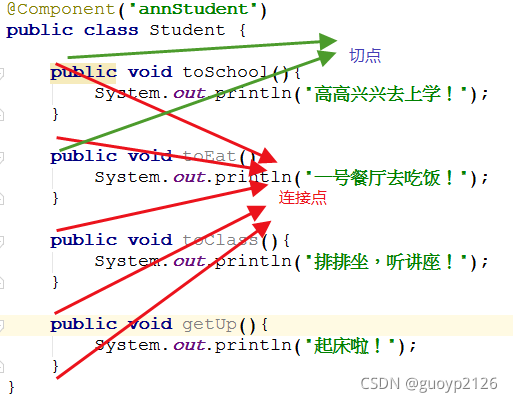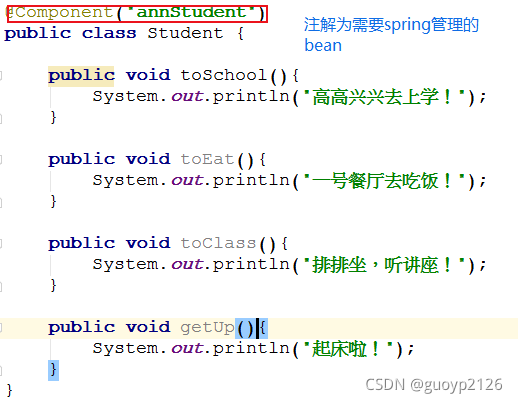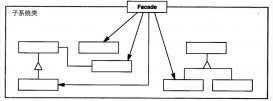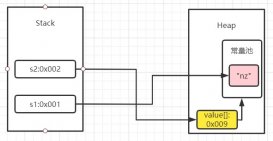引言
在实际应用场景中,我们封装一个学生的类,这个类用于封装学生的日常行为,如:上学、吃饭、上课等。然而,在疫情期间,学生上学时入校、吃饭时进入餐厅,需要测温查验证件等行为,拿到这样的需求我们怎么办?
不好的解决方案
面向过程的解决方案
遇到问题解决问题,在上学、吃饭方法中加上测温、查验证件方法,或者在学生类中提炼一个测温查验证件私有的方法,在需要时调用。
代码如下:
public class Student {
public void toSchool(){
check();
System.out.println("高高兴兴去上学!");
}
public void toEat(){
check();
System.out.println("一号餐厅去吃饭!");
}
public void toClass(){
System.out.println("排排坐,听讲座!");
}
public void getUp(){
System.out.println("起床啦!");
}
private void check(){
System.out.println("查验证件、测体温");
}
}
这种方式存在问题只是头痛医头、脚痛医脚,代码硬拷贝,现在教师进校门也要查验证件测温,如何办?将check代码复制到教师类中,再者,如果check()中业务规则发生变化,则需要到处改代码,显然是一种非常蹩脚的解决方案。
使用继承解决方案
创建一个man的基类,将check()方法放到该类中,教师、学生均继承此类,子类调用这个方法即可,
代码如下:
public class Man {
protected void check(){
System.out.println("查验证件、测体温");
}
}
public class Student extends Man {
public void toSchool(){
check();
System.out.println("高高兴兴去上学!");
}
public void toEat(){
check();
System.out.println("一号餐厅去吃饭!");
}
}
public class Teacher extends Man {
public void toSchool(){
check();
System.out.println("高高兴兴去上班!");
}
public void toEat(){
check();
System.out.println("教工餐厅去吃饭!");
}
public void toClass(){
System.out.println("排排坐,听讲座!");
}
}
这种方式,虽然解决了代码复制问题,但违背了面向对象程序设计的单一职责原则,因为查验证件测温等均不是学生或教师应该拥有的职责,类的划分职责不清,增加了代码扩展维护的难度。
使用聚合的解决方案
将查验证件测温等行为封装一个独立的类,学生和教师的依然只封装他们固有的方法,
代码如下:
public class Checktor {
public void takeTemperature(){
System.out.println("查验证件、测体温");
}
}
public class Student {
private Checktor checktor = new Checktor();
public void toSchool(){
checktor.takeTemperature();
System.out.println("高高兴兴去上学!");
}
public void toEat(){
checktor.takeTemperature();
System.out.println("一号餐厅去吃饭!");
}
}
这种方法很好的解决了面向对象程序设计单一职责原则,体现了类的封装性,但是代码侵入性很强,而且代码僵化,维护性差。如疫情结束了,我们要求取消查验证件和测温,就需要改原有的代码,破坏了开闭原则,增加了程序员的工作量。有些人写配置开关变量,在调用时使用ifelse进行判断是否调用也能遵循开关变量,但是代码中包含了一些可能用不到代码,不优雅,不是很好解决方案。
面向切面的编程基本概念
面向切面的编程是不破坏原有类封装性的前提下,动态在其方法前面(before)、后边(after)及周围(Around)(前面和后边)增强功能。
- 连接点(Joinpoint):目标对象中每个方法前面、后面均为连接点。如学生类中toSchool、toEat、toClass、getUp方法前面后面均是切入点;
- 切入点(Point):需要增强功能方法前面或后面,是切入点,如进学校前、吃饭前需要测体温,则toSchool、toEat两个方法前是切入点,其余的不是;

- 切面类(Aspect):也称通知类,封装了需要增强功能的类,如:Checktor;
- 通知方法(advice):需要增强的功能,如:测温方法;
- 通知类型:前置通知(Before)、后置通知(After)、环绕通知(around)、异常通知(throwing)、最终通知(after (finally) advice);

- 代理(proxy):将通知应用到目标对象实现机制,是通过创建代理对象完成的
- 织入(Weaving):将切面代码插入到目标对象上,生成代理对象的过程
基于Spring面向切面程序实现
针对学生上学场景,Spring的使用XML和注解两设计种方式完成面向切面的编程。
工程依赖项:在maven pom文件中,需要引入以下依赖项
<dependency>
<groupId>org.aspectj</groupId>
<artifactId>aspectjtools</artifactId>
<version>1.8.9</version>
</dependency>
<dependency>
<groupId>org.aspectj</groupId>
<artifactId>aspectjrt</artifactId>
<version>1.5.4</version>
</dependency>
<dependency>
<groupId>org.aspectj</groupId>
<artifactId>aspectjweaver</artifactId>
<version>1.9.5</version>
<scope>runtime</scope>
</dependency>
XML方式:
学生类:
public class Student {
public void toSchool(){
System.out.println("高高兴兴去上学!");
}
public void toEat(){
System.out.println("一号餐厅去吃饭!");
}
public void toClass(){
System.out.println("排排坐,听讲座!");
}
public void getUp(){
System.out.println("起床啦!");
}
}
切面类:
public class Checktor {
public void takeTemperature(){
System.out.println("测体温啦!");
}
public void washHand(){
System.out.println("洗洗手更健康!");
}
}
xml文件
<?xml version="1.0" encoding="UTF-8"?>
<beans xmlns="http://www.springframework.org/schema/beans"
xmlns:xsi="http://www.w3.org/2001/XMLSchema-instance" xmlns:aop="http://www.springframework.org/schema/aop"
xmlns:context="http://www.springframework.org/schema/context"
xsi:schemaLocation="http://www.springframework.org/schema/beans http://www.springframework.org/schema/beans/spring-beans.xsd http://www.springframework.org/schema/aop https://www.springframework.org/schema/aop/spring-aop.xsd http://www.springframework.org/schema/context https://www.springframework.org/schema/context/spring-context.xsd">
<context:component-scan base-package="com.bjwl.*"/>
<!--目标(业务)对象-->
<bean id="student" class="com.bjwl.xmltest.Student"/>
<bean id="teacher" class="com.bjwl.xmltest.Teacher"/>
<!--通知(切面)对象-->
<bean id="checktor" class="com.bjwl.xmltest.Checktor"></bean>
<aop:config>
<!--定义(切面)对象-->
<aop:aspect ref="checktor">
<!--定义切点-->
<aop:pointcut id="point_test_d" expression="execution(* com.bjwl.xmltest.Student.to*(..))"/>
<!--定义通知-->
<aop:before method="takeTemperature" pointcut-ref="point_test_d"></aop:before>
<aop:after method="washHand" pointcut-ref="point_test_d"></aop:after>
</aop:aspect>
</aop:config>
</beans>
其中:目标对象是student对象,切点是student对象中方法名前两个字母是to的所有方法,事前执行测温(takeTemperature)、事后执行洗手(washHand)
测试代码如下:
public class StudentTest {
@Test
public void toSchool() {
ApplicationContext applicationContext = new ClassPathXmlApplicationContext(
"bean02.xml"
);
Student student = (Student)applicationContext.getBean("student");
student.toSchool();
}
}
运行结果如下:

如果教师需也需要测温,编写教师类,代码如下:
public class Teacher {
public void toSchool(){
System.out.println("高高兴兴去上班!");
}
public void toEat(){
System.out.println("教工餐厅去吃饭!");
}
public void toClass(){
System.out.println("排排坐,听讲座!");
}
}
xml文件更改如下:
<aop:config>
<!--定义(切面)对象-->
<aop:aspect ref="checktor">
<!--定义切点-->
<aop:pointcut id="point_test_d" expression="execution(* com.bjwl.xmltest.*.to*(..))"/>
<!--定义通知-->
<aop:before method="takeTemperature" pointcut-ref="point_test_d"></aop:before>
<aop:after method="washHand" pointcut-ref="point_test_d"></aop:after>
</aop:aspect>
</aop:config>
则表示com.bjwl.xmltest中的所有类的对象均为目标对象,前两个字母带to的方法前后均为切点。
注解方式:
学生类代码:

切面类的代码

xml文件:

运行结果等同,XML文件。
这样做的好处,学生类、教师类、切面类具有职责单一性,提现业务逻辑封装性,动态增强符合开闭原则。
小结
以上简单的介绍了面向切面编程的基本概念和基本用法。用好面向切面的编程技术很不易,因为切点只能设置到需要增强功能前面或后面,对程序设计人员要求很高,要求能够根据编程经验和技巧设计出合理的切点,需要提现类的层次性。如:执行SQL语句前,在控制台输出完整的SQL语句的切点,切点就不能设置到你自己定义的Dao中,而是设置在PrepareStatement的exectuce的方法前。不过也不用担心,使用各种框架时,常用的日志等,已经给我们设置了开关变量,我们直接使用即可,非常简单。
以上就是java开发AOP面向切面编程入门的详细内容,更多关于java面向切面编程的资料请关注服务器之家其它相关文章!
原文链接:https://blog.csdn.net/guoyp2126/article/details/120247685















